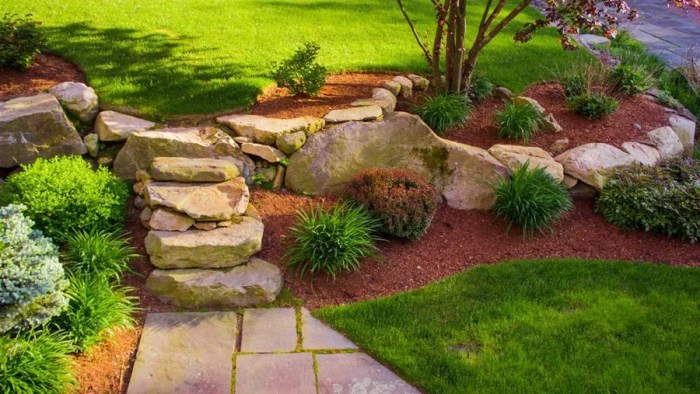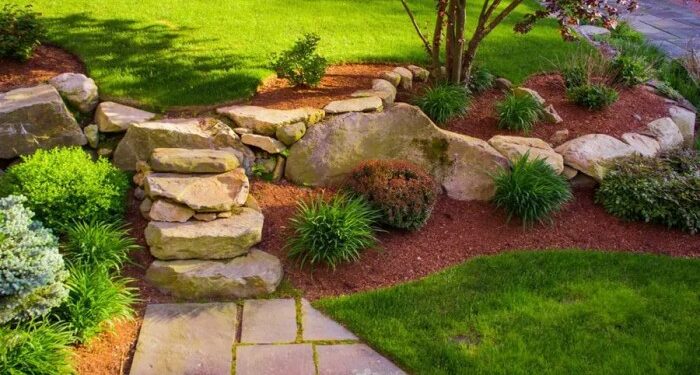Embark on a journey to explore affordable backyard landscaping solutions that will revolutionize your outdoor space without breaking the bank. From cost-effective materials to budget-friendly plants, this guide covers everything you need to know to create a stunning backyard oasis within your means.
Discover innovative ideas for maximizing space, incorporating recycled materials, and engaging in fun DIY projects to elevate your backyard landscape without draining your wallet.
Researching Affordable Backyard Landscaping Solutions
When looking for affordable backyard landscaping solutions, it's important to consider cost-effective materials and budget-friendly plants that can transform your outdoor space without breaking the bank. Additionally, finding affordable landscaping services can help bring your vision to life without exceeding your budget.
Cost-Effective Materials for Landscaping
Using recycled materials, such as reclaimed wood or concrete pavers, can be a budget-friendly option for your backyard landscaping project. These materials can add a unique touch to your outdoor space while being environmentally friendly and cost-effective.
Budget-Friendly Plants Suitable for Backyard Landscaping
- Consider native plants that are well-suited to your climate and require less maintenance, reducing the need for costly watering and fertilizing.
- Opt for perennial plants that come back year after year, saving you money on replanting annually.
- Look for plants that are easy to propagate, allowing you to expand your garden without spending a fortune on new plants.
Tips on Finding Affordable Landscaping Services
- Get quotes from multiple landscaping companies to compare prices and services offered. Don't be afraid to negotiate for a lower price or ask for discounts.
- Consider hiring a landscaping student or apprentice who may offer services at a lower rate while gaining valuable experience.
- Check for seasonal promotions or discounts offered by landscaping companies to save money on your backyard project.
Designing a Budget-Friendly Backyard Landscape
When working with a limited budget, it's essential to get creative with your backyard landscaping ideas. Here are some tips to help you maximize space, use recycled materials, and incorporate DIY projects for a cost-effective outdoor oasis.
Maximizing Space in a Small Backyard
Small backyards can still be transformed into beautiful and functional spaces with the right design approach. Consider the following ideas:
- Vertical gardening: Utilize walls or fences for planting vertical gardens to save space.
- Multipurpose furniture: Opt for dual-purpose furniture items like benches with storage or tables that can also serve as planters.
- Paving stones: Use paving stones to create pathways and define different areas in your backyard without taking up too much space.
Using Recycled Materials in Landscaping Design
Using recycled materials not only helps the environment but also adds a unique touch to your backyard landscape. Here are some creative ways to incorporate recycled materials:
- Old tires: Paint old tires and stack them to create a colorful planter bed or use them as a base for an outdoor seating area.
- Pallets: Repurpose wooden pallets into DIY furniture, planters, or even a vertical garden wall.
- Broken concrete: Instead of discarding broken concrete pieces, use them to create a rustic pathway or retaining walls.
Incorporating DIY Projects for Cost-Saving
DIY projects are not only budget-friendly but also allow you to add a personal touch to your backyard landscape. Here are some ideas for DIY projects:
- Building a fire pit: Create a cozy outdoor gathering spot by building a fire pit using affordable materials like bricks or stone.
- Repurposing old furniture: Give new life to old furniture pieces by repainting them or turning them into planters or decorative accents.
- Creating a herb garden: Start a DIY herb garden using recycled containers or wooden crates to grow fresh herbs for cooking.
Implementing Sustainable Practices in Backyard Landscaping
Creating a sustainable backyard landscape not only benefits the environment but also helps save money in the long run. By incorporating sustainable practices, you can reduce water usage, maintenance costs, and promote biodiversity.
Benefits of Using Native Plants
Native plants are well-suited to the local climate and soil conditions, requiring less water, fertilizer, and pesticides
- Native plants are low-maintenance and resilient, reducing the need for watering and chemical inputs.
- They help prevent soil erosion and filter pollutants, improving overall soil health.
- Native plants attract beneficial insects and pollinators, contributing to a balanced ecosystem.
Water Conservation Techniques
Conserving water in your backyard landscape is essential for sustainable gardening practices. By implementing water-saving techniques, you can reduce water waste and lower your utility bills.
- Install a rain barrel to collect rainwater for watering plants, reducing the need for tap water.
- Use drip irrigation systems to deliver water directly to the roots of plants, minimizing evaporation.
- Mulch around plants to retain soil moisture and suppress weed growth, reducing the frequency of watering.
Importance of Composting and Mulching
Composting and mulching are valuable practices in sustainable backyard landscaping. They help improve soil fertility, retain moisture, and reduce the need for chemical fertilizers.
- Composting kitchen scraps and yard waste creates nutrient-rich soil amendment for plants, reducing the need for synthetic fertilizers.
- Mulching with organic materials like leaves, grass clippings, or wood chips helps retain soil moisture, suppress weeds, and regulate soil temperature.
- Both composting and mulching contribute to healthy soil biology, promoting plant growth and overall ecosystem health.
Creating a Low-Maintenance Backyard Landscape
When it comes to designing a low-maintenance backyard landscape, choosing the right plants, efficient irrigation systems, and hardscaping elements can make a significant difference in reducing the time and effort required for upkeep.
Identifying Low-Maintenance Plants and Shrubs
One of the key aspects of creating a low-maintenance backyard landscape is selecting plants and shrubs that require minimal care. Opt for native plants that are well-suited to your climate and soil conditions, as they tend to thrive with less maintenance.
Drought-tolerant plants, such as lavender, succulents, and ornamental grasses, are great choices as they require less water and attention. Consider planting perennials that come back year after year, reducing the need for replanting.
Efficient Irrigation Systems
Installing an efficient irrigation system is essential for minimizing maintenance in your backyard landscape. Drip irrigation systems deliver water directly to the roots of plants, reducing water waste and the need for frequent watering. Consider incorporating a timer to automate watering schedules and ensure that plants receive the right amount of water without overwatering or underwatering.
Using Hardscaping Elements
Incorporating hardscaping elements such as pathways, patios, and rock gardens can help reduce the need for constant maintenance in your backyard landscape. Hardscaping features require minimal upkeep compared to traditional landscaping elements like grass and flower beds. Use materials like gravel, mulch, or pavers to create defined spaces that add visual interest while minimizing maintenance requirements.
Ending Remarks

In conclusion, affordable backyard landscaping solutions offer endless possibilities for transforming your outdoor space into a beautiful and sustainable haven. By implementing cost-effective strategies and sustainable practices, you can achieve a low-maintenance backyard landscape that surpasses your expectations. Start your landscaping journey today and watch your backyard thrive with creativity and affordability.
FAQ Insights
What are some cost-effective materials for backyard landscaping?
Consider using gravel, mulch, or pea gravel for pathways and ground cover to save on costs.
How can I maximize space in a small backyard?
Utilize vertical gardening techniques, such as trellises and hanging planters, to make the most of limited space.
Why is composting important in reducing landscaping costs?
Composting enriches the soil naturally, reducing the need for expensive fertilizers and improving plant health.














